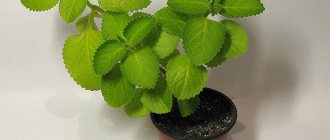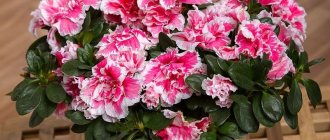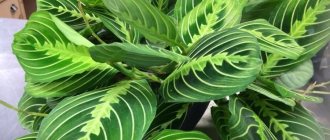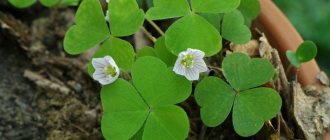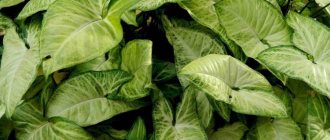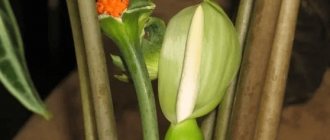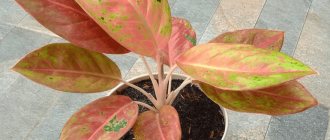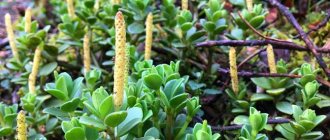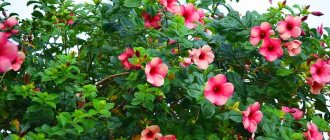Recently, a friend sent me a photo of a flower that she was given as a gift called “room mint” and was recommended to make tea from it. I immediately guessed the plant; it turned out to be my favorite plectranthus. Having started to study information about the plant in more detail, I found out that plectratus is not only a spectacular ampel. They actually make fragrant tea from it. They are also used to treat many diseases, to fight moths and even to attract money! Read more about plectranthus, or spur flower, in this article.
Indoor mint: video of a candidate of agricultural sciences on how to care for plectranthus (read more) Plectranthus - beautiful, fragrant and healthy.
What is plectranthus?
Plectranthus is a semi-succulent perennial with a woody base and grows as an evergreen in the south. Plectranthus has characteristic thick fluffy leaves with a strong pleasant smell; they can be round, heart-shaped or triangular in shape, with jagged, wavy edges. The flowers are in two-lipped spikes or panicles and can be white, pink or lavender. The height of the plant varies greatly depending on the species - from 15 cm to 1 m or more, many species spread along the ground or grow like ampels.
In the middle zone, indoor mint is grown as a heat-loving annual or indoor flower. Primarily valued for its attractive foliage. Plectranthus is an excellent addition to arrangements of colorful annuals. Cuttings can also be planted directly in a flower bed, as the plant grows quickly.
Note! Sometimes plectrnathus is confused with ivy leaf, especially with its variegated form. But budra has smaller leaves and they feel less dense and not at all as juicy as those of plectranthus. The stems of the budra are thin and drooping.
What to do after buying indoor mint
Having chosen your favorite plectranthus bush in a store or from familiar gardeners, you must carefully place it in a container suitable for transportation, for example, in a box, so as not to damage the stems.
From a small purchased container, the plant must be transplanted into a tall, medium-sized ceramic pot by transferring it along with a lump of existing soil, being careful not to damage the root system. Drainage is poured into the bottom of the pot. For replanting you will need fertile soil with a low acidity level. This way, indoor mint will take root well and grow.
Plectranthus coleus
Plectranthus coleoides Marginatus, Plectranthus forsteri) is one of the most popular plant species that can often be found in urban landscaping. In particular, I first encountered it when I saw a magnificent composition in the phytodesign of a cafe. This variegated plectranthus grew in the company of bright red geraniums, which looked stunningly impressive. Later I managed to find out what kind of plant it was and purchased its cuttings. Plectranthus coleus is a small bush up to 25-30 cm high and 50-60 cm wide with green serrated leaves with a maximum length of about 4 cm.
Plectranthus forsteri, variation "Marginatus".
The most popular in decorative floriculture is the variegated variation of Plectranthus Forster “Marginatus”, or “Variegatus” . This is a very bushy plant with bright green jagged leaves beautifully edged with a creamy stripe. In autumn, the plant may bloom with small lavender or white flowers. Stems and leaves are sparsely pubescent, with long and short hairs. When grown in a container, the weight of the leaves causes the shoots to droop, which is why this plant is popular as an ampel.
As for the smell, this type of plectranthus has perhaps the most intense one, most often described as camphorous, but personally I feel that this plant smells of incense. Different people's attitudes towards this scent may differ. But personally (although the smell is harsh) it has a calming effect on me.
Care errors and their elimination
Frequently encountered problems when growing Plectranthus and how to eliminate them:
| Problem | Causes | Solution |
| Yellowing and falling leaves | Keeping in a cold room | Regulate the temperature, avoid overcooling the plant |
| Wilting of leaves and shoots | Moisture deficiency | Do not allow the soil to dry out |
| The appearance of a light green color of leaves, a decrease in their size | Keeping in direct sunlight | Place the flowerpot under bright diffused light |
Plectranthus silver
Silver plectranthus (Plectranthus argentatus) is valued for its attractive, fluffy grey-green foliage that appears to be covered in frost. Most often, we grow its varietal variation “ Silver Shield”. This cultivar is more compact than the species plant and usually grows up to 30 cm in height and up to 60 cm in width. The leaves are ovate, pointed, gray-green with a combed edge, covered with dense silvery pubescence. The stems are erect, but in hanging baskets the bush grows as a hanging bush. Tubular, bluish-white flowers are collected in spike-shaped inflorescences and bloom in mid-summer.
Silver plectranthus (Plectranthus argentatus).
This hybrid can be easily grown from seeds sown indoors 4-6 weeks before the intended planting in a permanent location. I grew silver plectranthus from seeds. The process of growing plectranthus seedlings does not present any difficulties, and its cultivation is similar to sowing coleus. Plants from seeds develop very quickly and reach their peak decorative value by mid-summer, having time to bloom. The mother plant can be brought into the house for the winter, grown as a houseplant, and cut in the spring.
I really liked combining silver plectranthus with beautifully flowering plants with cool-colored petals, for example, purple petunias, blue brachycoma, blue ageratum and others. Plectranthus looks especially impressive hanging from a hanging basket. The aroma of this plectranthus is also similar to incense or camphor, but slightly weaker than that of the coleus.
Pests and diseases
At home, pests and diseases rarely attack mint. However, it can suffer from spider mites, aphids and scale insects, root rot, and downy mildew.
When pests appear, the leaves of the plant are treated with a solution of laundry soap or special insecticides for garden and indoor plants. If the plant has suffered from fungal diseases, it is necessary to reconsider the watering regime. The emerging rot is combated using Bordeaux mixture or fungicides, for example, Horus, Topaz and others.
Plectranthus blushes
Plectranthus purpuratus is an erect, spreading plant with dark green, fleshy leaves that are distinguished by a purple tint on the reverse side; the stems can also be purple. Against the green background of the foliage, the beet-colored veins look very decorative; the young leaves are almost entirely purple, so the bushes look multicolored. The shape of the leaves is slightly rounded and jagged.
Plectranthus purpuratus.
Blooming Plectranthus ruddens.
Inflorescences appear on the tips of the shoots - this is a spike 30-120 mm long, often with two lateral branches. The flowers are tiny, two-lipped, white to bluish speckled. In indoor conditions, this type of plectranthus blooms from September to May. The height of the bush does not exceed 30 centimeters; in pots it also behaves like an ampel.
Not only is it a showy houseplant, it is ideal for rockeries, containers or as a ground cover for shade. I first became acquainted with this plant when I saw it in a flowerbed near a flower shop, where it formed a dense mat that looked very unusual, since this type of plectranthus is very rarely used as a flowerbed plant.
For me, plectranthus turned out to be a wonderful hanging plant for balcony boxes, where it formed a magnificent duet with petunias and pethoa in warm sunny shades (yellow, orange, ivory). Unlike other types of plectranthus, this is one of the most compact species and does not take up too much space in the pot.
When I bring the mother plants in for the winter, they give me their pretty blooms in October, their speckled flowers reminiscent of tiny orchids, and the white petals against the burgundy foliage looking especially attractive. Believe it or not, this plectranthus smells like basil. But its aroma is weaker than that of other species.
Keeping spur flowers at home
Despite its unpretentiousness, as a native of the subtropics, indoor mint needs to provide an environment close to natural conditions: light, warmth, moisture, fresh air. Able to tolerate slight darkening well, plectranthus prefers to live on window sills on the east or west side.
Placement on the south side and exposure to direct rays of the sun can lead to loss of decorativeness - shredding of leaves. The shortened daylight hours are well compensated by artificial lighting. In summer, he enjoys being outdoors - on the balcony or in the garden.
Indoor mint adapts remarkably well to new conditions. After purchase, it needs to be transplanted into a larger diameter pot along with soil on the roots. Up to five years it is recommended to replant annually, later - after 2 years. In spring it can be planted in open ground. The soil for indoor mint is recommended not to be too dense, consisting of humus and turf soil, as well as leaf soil, river sand and peat in the required proportions.
Spurflower is demanding in terms of care when it comes to thermal conditions, which in summer should be between 18-25 degrees, and in winter not lower than 12-16. If you cannot maintain the optimal temperature, you need to compensate for this deficiency with sufficient illumination. Lack of light and excess heat can lead to loss of decorativeness and overgrowth.
For dynamic growth, indoor mint needs a large amount of moisture, especially during vigorous development and strengthening. A comfortable environment for Swedish ivy is created by simulating a subtropical microclimate in the form of spraying. Although the flower will tolerate short drying without harm, it is better to try not to abuse it.
In winter, the growth of the moth tree stops and it falls into a relatively calm state. At this stage, it is recommended to water sparingly - once every 3-4 days; a slightly dried top layer of soil helps maintain the dormant state of the plant. Use settled water for irrigation.
For feeding, fertilizers intended for indoor plants or organic ones are used alternately with mineral ones. Their application is required at stages of increased growth - in the summer and spring seasons.
In the spring, plectranthus, which has grown over the winter, should be cut off by half so that it begins to develop intensively again. Bare and weakened stems are usually pruned. When it reaches the optimal height, it is pinched to stop growth, the formation of young shoots and the growth of a lush bush. Such pruning can be done throughout the whole year, eliminating stunted or too thick shoots. Most gardeners refresh a flower from a cutting every two years.
Indoor mint is propagated by dividing the bushes during transplantation. This is simple even for an inexperienced gardener, not to mention a skilled one. The stem easily takes root in water, soil or wet sand. After about a week and a half, the newcomer with grown roots is ready for planting. To immediately get a spreading plant, several shoots can be planted in one flowerpot.
Plectranthus blooming
Flowering plectranthus (Plectranthus neochilus) is a low ground cover plant with velvety, pubescent foliage. The leaf blade is bluish-green due to pubescence. “ Dwarf Variegated” with a light wide leaf border is more common The leaves are medium-sized, rounded with slightly jagged edges. These are low bushes, usually they do not exceed 25 cm, and they grow a little slower than other species.
Flowering plectranthus (Plectranthus neochilus).
This variety of spur flower is distinguished by the longest attractive flowering, since its spike-shaped inflorescence is denser and denser and consists of bright blue two-lipped flowers. In its homeland and in the southern regions, the flowering spur flower is in bloom for a long time, almost all year round. Attractive spikelets rise above the carpet of variegated leaves to a height of 15 cm and look very impressive, slightly reminiscent of the flowering of creeping tenacious.
Most often this species is used as a ground cover, but it can also be used as an hanging plant. Although, in my experience, flowering plectranthus does not grow so quickly and does not form a very long ampel from cuttings over the summer. On my balcony, this interesting, delicate plant looked very good in hanging baskets in combination with pastel-colored annuals, such as pink petunia and bacopa. In the plant’s homeland, it is believed that the flowering plectranthus, with its strong and pungent odor, scares away snakes from people’s homes. The smell of this type of plectranthus is almost identical to bitter wormwood.
Types and varieties of plectranthus
There are 350 varieties in the world. But no more than half of this extensive list is suitable for keeping indoors. Here are just a few views with photos:
- Fragrant – variety also known as Cuban oregano, French thyme, Indian borage. Distinctive feature: large – up to 7 cm in length – leaf with a delicate mint aroma. The chemical composition is rich in useful substances that have a beneficial effect on the human body.
- Coleus is one of the most common species. A large number of spectacular hybrids have been selected based on the maternal species. For example, Marginatus is a variety with two-color leaf blades.
- Mona Lavender is a favorite among gardeners. Compact plant with a long flowering period. In comfortable conditions it can bloom 8-9 months a year. A characteristic feature is a large flower of a lilac hue.
- Southern (Swedish ivy) is an ampelous species, characterized by its unpretentiousness. With proper care, the length of the whip can reach 1.5 meters in length. It is grown mainly as an ornamental foliage plant.
- Oakleaf is a rare species, so named not only because of its external resemblance to the oak tree. The chemical composition is rich in tannins. It is valued by phytodesigners for the special plasticity of the trunk, which can be woven into a rope when creating compositions.
- Plectranthus Ernst is a caudex species with a characteristic thickening at the base of the trunk. Well known to lovers of the art of bonsai. In its natural habitat it blooms with small lilac flowers.
Healing plectranthus aromatic
Plectranthus tea is usually brewed from only one species of spur flower, Plectranthus aromatica. Although it does not have such an attractive and even quite ordinary appearance, compared to its decorative counterparts, this plant is famous for its medicinal properties, and also has some other uses in everyday life.
Plectranthus amboinicus is distributed mainly in Tropical Africa, Asia and Australia. This is a perennial plant with thick, succulent tetrahedral stems of brown or green color and fleshy green leaves of a round shape with a wavy edge. It grows in the form of branched, spreading bushes from 50 to 100 cm in height. Sometimes this plant is also called “cubano oregano” because its smell is very reminiscent of the spice oregano (oregano).
Plectranthus amboinicus (Plectranthus amboinicus).
As a medicine, plectranthus aromatica is used to treat a wide range of diseases. A decoction of the leaves is primarily used for respiratory diseases accompanied by nasal congestion, bronchitis, and sore throat. It also helps with diseases of the digestive system (dysentery, diarrhea, colitis, etc.). It is believed that fragrant plectranthus can be effective in urolithiasis, and also has antiepileptic, antitumor and antimicrobial properties.
The leaves have a strong aroma and are used as a seasoning either fresh or dried. Most often, the plant serves as a substitute for oregano and is suitable for filling poultry, beef, lamb and game, and is also added to soups and pizza.
Medicinal plants: name, description, medicinal properties (read more)
Tasters of plectranthus tea are divided on its taste and aroma. To some it seems more like oregano, to others like lemon balm, but since the plant contains menthol in large quantities, the taste of this tea is still similar to mint. At the same time, many also note that the menthol taste is too strong, and that plectranthus tea is still inferior in taste to real mint tea.
To brew tea from plectranthus, you need to pick a few (3-4) medium-sized leaves, pour boiling water over them, cool and add sugar to taste. Plectranthus deciduous tea has a soothing and anti-inflammatory effect.
Note! The plant also has contraindications. Plectranthus is not recommended for pregnant and lactating women, although in India this drink is used in a short course to improve milk production. It is also best not to offer this herb to children under 12 years of age. People with sensitive skin should avoid contact with plectranthus foliage as it may cause irritation. It is also better for those with hypotension and those suffering from varicose veins to avoid using the spur flower as food.
Main types
Plectranthus can be annual or perennial. This is a hanging plant, characterized by drooping branches. Therefore, it must be planted in hanging pots. Non-ampelic plants are also found, but their distribution is not so wide. Types of plectranthus differ not only in leaves, but also in inflorescences. In some plants they are completely unattractive, while others are in demand only due to their unusual flowering.
Plectranthus
The leaves of indoor mint differ in texture and shape, have different edges and colors. For example:
- Southern plectranthus grows horizontally, its leaves are green and covered with wax. Therefore they are dense and smooth;
- Forstera also grows horizontally. The plant is used to decorate loggias and balconies. Its leaves are ovoid in shape and have a pronounced relief. White stripes along the edges contrast with the green color.
- The leaves of Plectranthus oakleaf are covered with hair, so they are fluffy. If you touch them, a pine aroma appears. Their shape is identical to oak leaves, which is reflected in the name;
- Plectranthus variegata is distinguished by heart-shaped leaves. They are colored green and have a white border around the edges.
Plectranthus Ertendahl
Plectranthus Ertendahl, or spur flower, is a perennial shrub whose height does not exceed 20 centimeters. Its leaves are ovoid, even almost round, green. They have a bright pattern along the veins of a silvery hue. On the reverse side, the leaves are red in color and feel rough to the touch.
Plectranthus Ertendahl
Inflorescences form at the top of the plectranthus. They reach a length of up to 30 centimeters. Consist of several large white flowers. The plant reacts to light by changing the shade of its leaves. With too much sun, redness on the back side moves to the front side. This species requires constant pinching to create bushiness.
Plectranthus tomentosa
Plectranthus tomentosa, or hadiensis, is distinguished by the fact that its light green leaves are covered with short down. The color is usually monochromatic, but variegated plants are also found. At the same time, there are different shades, they can be yellow, mint and dark green.
Hadiensis is common in India, where it is used as one of the ingredients in cooking. At home, the plant looks compact, with branches strewn with small leaves hanging from the pot. Under natural conditions, plectranthus can reach 70 centimeters in height. This is one of the most light-loving representatives of indoor mint. During flowering, beautiful blue flowers appear.
Plectranthus Mona Lavender
The stems of Plectranthus Mona Lavender are long, hard, and covered with down. Their color is brownish-brown. The leaves of the plant are glossy, dense, and the surface is jagged. On the other side, purple lint is visible.
Plectranthus Mona Lavender
Peduncles form at the top of the stem; leaves do not grow on them. They are also lightly covered in down. The flowers themselves resemble elongated bells and can have different colors. In nature there are white, lilac, purple, and lavender shades. Due to its attractiveness during flowering, this species has gained the greatest popularity among plant lovers. In addition, the duration of this colorful period is attractive. With proper care, the plant can delight with its bright appearance from February to November.
What else is plectranthus useful for?
Plectranthus can help eliminate itching and inflammation after an insect bite; to do this, apply a crushed leaf to the bite and wrap it with a bandage. This plant releases phytoncides, so it improves the health of the air in the house, killing pathogenic bacteria. It is believed that if a plectranthus bush grows in the bedroom, it will have a beneficial effect on the nervous system, promoting relaxation, relief from anxiety and good sleep.
Plectranthus leaves in gauze bags placed in a closet can protect its contents from moths, since the insect does not like the smell of the plant. One of the popular names for plectranthus is “moth tree”.
Plectranthus coleus in the composition.
Plectranthus blushes in the composition.
Also, plectranthus is another variant of the “money tree”. Many flower growers endow it with the ability to increase the well-being of the person who cares for it.
Interpretation will accept
Plectranthus positively characterize folk signs. According to popular superstitions, it is believed that the spur flower, like the “money tree,” attracts financial well-being, prosperity and success to the home and family. In addition, it drives away bad thoughts, relieves anxiety, and helps eliminate sleep problems. He is called an individual free psychotherapist who knows how to protect against negative emotions.
Moreover, the ability to bestow prosperity manifests itself not only on its owners, but even on those who care for it or are simply located nearby.
Caring for plectranthus at home
Plectranthus requires well-drained and fertile soil. Before planting, add some compost, shredded rotten leaves or other organic material to the soil. Although the plant is fairly drought tolerant, it grows best with occasional watering, especially in hot, dry weather. Pinch the plant from time to time during active growth to keep the bushes compact and dense. Although plectranthus is relatively resistant to pests, in indoor conditions it can sometimes be affected by spider mites, whiteflies and mealybugs.
Plectranthus blooming in the composition.
Ideally, spur flower should be grown in partial shade or dappled shade, so the leaves will retain a beautiful bright shade. If a plant receives too much sun, its leaves will turn yellow, begin to curl, and become unsightly. Variegated forms are more resistant to bright sunlight. It is best for plants to spend summer outdoors, where bushes can grow in a flower bed or in container arrangements. At the end of summer, the queen cells are taken indoors for the winter.
In an apartment, plectranthus behaves like an ordinary houseplant; it should be placed in a bright window and watering should be reduced. The main thing is that the temperature during wintering of indoor mint does not fall below plus 10 degrees. In spring it is very easy to propagate by cuttings, which quickly take root in water.
Features of seasonal care
Indoor mint actively develops and blooms in spring and summer. It requires moderate heat, bright diffused light, regular watering and fertilizing 2 times a month. Since autumn, the life processes of the plant slow down. He enters a period of relative peace. It is advisable to provide cooler conditions up to +16 degrees. Reduce the number of waterings and stop fertilizing. If the plectranthus remains to spend the winter in a warm room, it needs to be provided with enough light and include additional lighting. Also, fertilize once a month to provide nutrients.

